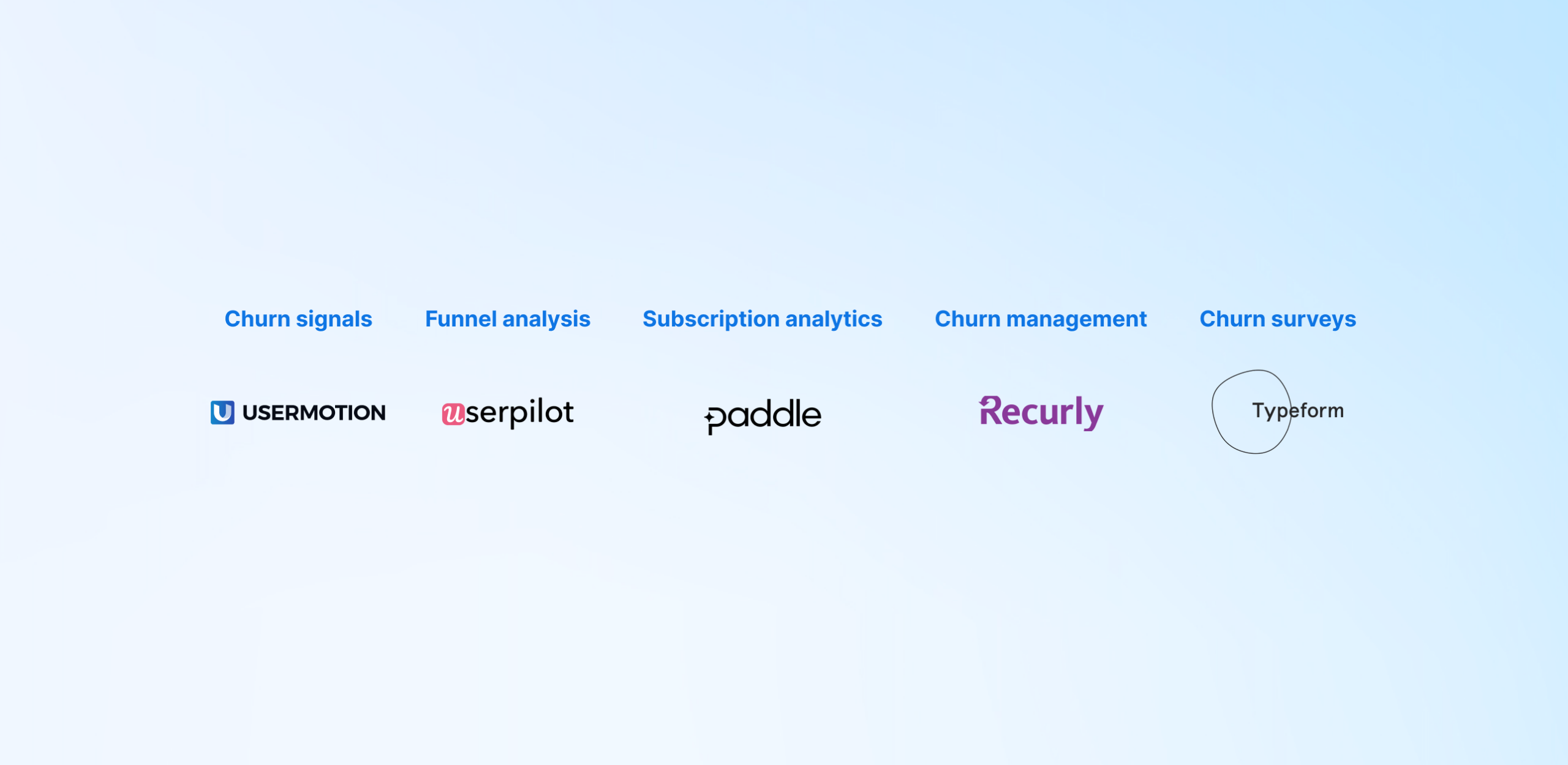Churn should be managed from start to finish. This process involves more than just churn rates; it also includes actions to predict and prevent churn to help control these rates.
All of this can be done with tools that are made for churn analytics or that help manage churn. If you can implement churn analytics data in your churn management, you will see how the data drive the whole strategy.
Table of contents
What is churn analytics?
Churn analytics is the process of collecting and analyzing data to understand why customers leave a service or stop buying products.
This involves looking at customer behavior, purchase history, service interactions, churn feedback, payment data and other relevant data points to identify patterns and predict which customers are at risk of churning.
What is churn analytics data?
Churn analytics data refers to the specific types of information gathered to determine the likelihood of customers discontinuing the use of a service or product.
- Customer behavior data:
- Usage frequency
- Session length
- Feature engagement
- Usage patterns
- Purchase history:
- Purchase records
- How often purchased
- Changes in buying patterns
- Service interactions:
- Customer service interactions
- Response times
- Issue resolution rates
- Customer satisfaction scores
- Churn feedback:
- Direct feedback from customers
- Payment data:
- Payment regularity
- Payment methods
- Demographic information:
- Customer company data
- Customer profile data
- Other demographic factors
Why we need them?
By using churn analytics, businesses can take proactive measures to retain customers. This might include detecting potential churn reasons, improving product offerings, or enhancing customer support—all based on the insights derived from the data.
- Detect potential churn reasons: Identify specific issues or trends that may be causing customers to leave.
- Improve product offerings: Adjust or enhance products based on customer usage and feedback data.
- Enhance customer support: Refine customer service strategies.
Implementing churn analytics effectively requires continuous monitoring and updating of strategies as new data comes in and market conditions change. That’s why we need such tools.
What is churn analytics tool?
A churn analytics tool is software designed to help businesses understand why customers leave. These tools collect and analyze customer data to find trends and risks related to customer retention. Here’s what these tools typically do:
- Data integration: They gather data from different sources like CRM systems, billing software, and customer interactions.
- Predictive analytics: Using machine learning, these tools predict which customers might leave by looking at past data and behaviors.
- Segmentation: They group customers based on similar traits or behaviors, which helps in creating targeted strategies to keep them.
- Dashboard and reporting: These tools provide easy-to-read dashboards and reports that show important information like churn rates and customer value.
- Automated alerts: They can send real-time alerts when a customer shows signs of possibly leaving, allowing quick action to keep them.
5 Churn Analytics Tools
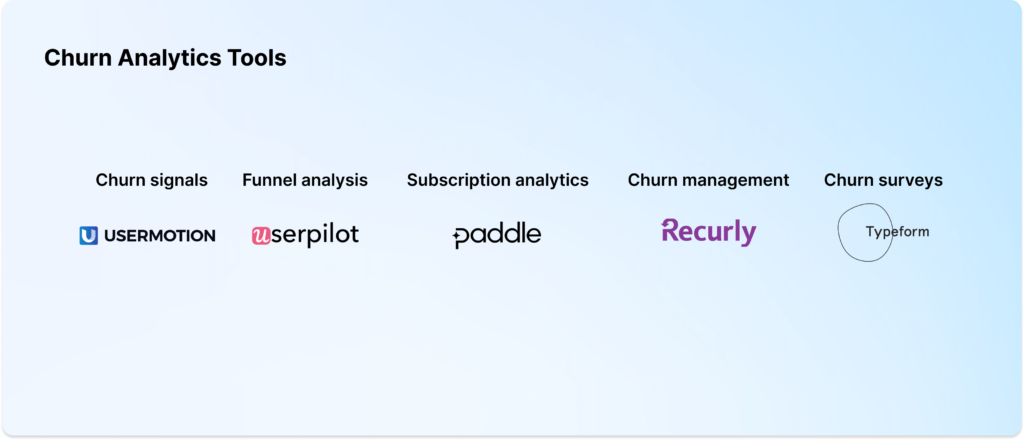
1. UserMotion: Churn signals
UserMotion is a churn analytics tool designed to help businesses identify and act upon signs of potential customer churn. This tool is equipped with various features and capabilities that enable proactive customer retention strategies.
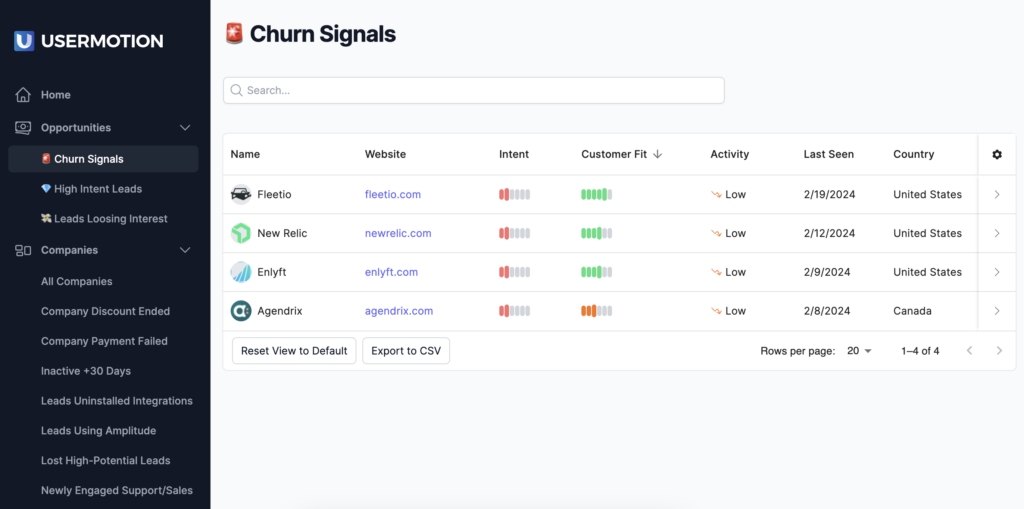
Being aware of these signals, users can predict who might be at risk of churn and based on the received data, they engage with the customer based on the insights received.
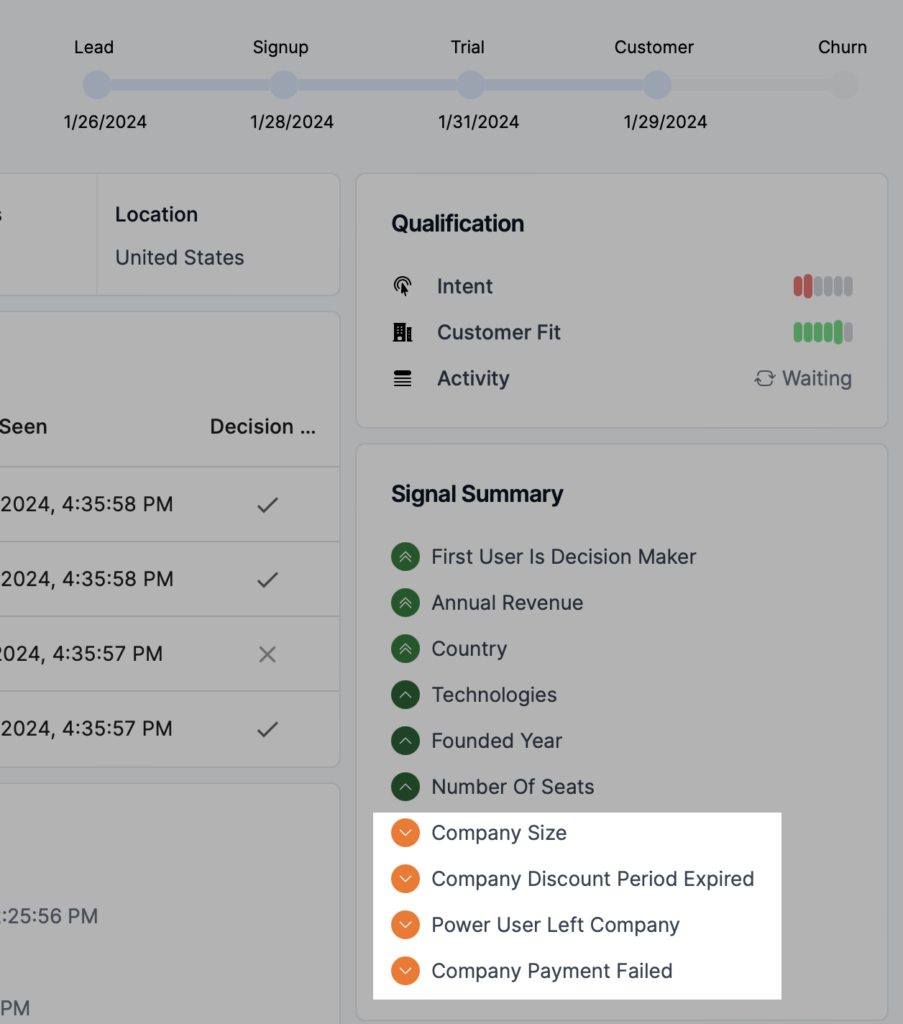
- Churn signals segment:
- The churn signals segment lists companies with their churn risk signals clearly displayed. This dashboard provides a quick overview of:
- Name and website
- Intent: A color-coded indicator showing the potential intent of the customer to either stay or leave, based on their interactions.
- Customer fit: Shows how well the customer characteristics align with the ICP.
- Activity levels
- Last seen
- The churn signals segment lists companies with their churn risk signals clearly displayed. This dashboard provides a quick overview of:
- Customer journey:
- UserMotion shows detailed timeline for a specific customer’s journey from lead to potential churn. It gives information about.
- Key milestones in the customer’s journey such as signup, trial, and purchase.
- UserMotion shows detailed timeline for a specific customer’s journey from lead to potential churn. It gives information about.
- Detailed intent signals summary:
- It also provides a summary of specific intent data. This includes:
- Qualification metrics: Data-driven insights into customer intent, fit, and activity which help predict churn.
- Signal summary: A summary of critical signals like decision-maker involvement, revenue details, and technical insights which might influence retention strategies.
- It also provides a summary of specific intent data. This includes:
- Segmentation and list management:
- UserMotion also helps you to segment customers based on various risk factors such as payment failures, loss of a power user, or extended inactivity.
- Custom lists: Users can create lists for specific segments like customers facing payment issues or those who haven’t engaged for over 30 days.
- UserMotion also helps you to segment customers based on various risk factors such as payment failures, loss of a power user, or extended inactivity.
By analyzing patterns in the data like customer engagement and fit, UserMotion predicts who is likely to churn, allowing for timely interventions. It translates data into actionable insights.
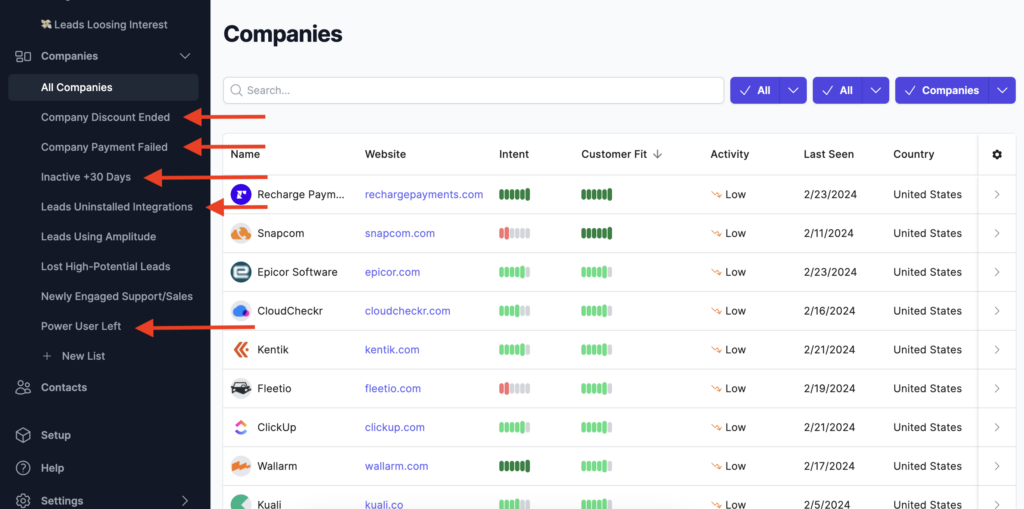
It also send automated alerts to notify users about critical churn risks, ensuring no high-risk customer goes unnoticed.
2. Userpilot: Funnel analysis
Userpilot positions itself as a product analytics, user engagement and user feedback tool, that helps with different type of churn analytics.
It helps tracking product growth, analyzing product user engagement to discover new value point and collect feedback from them.
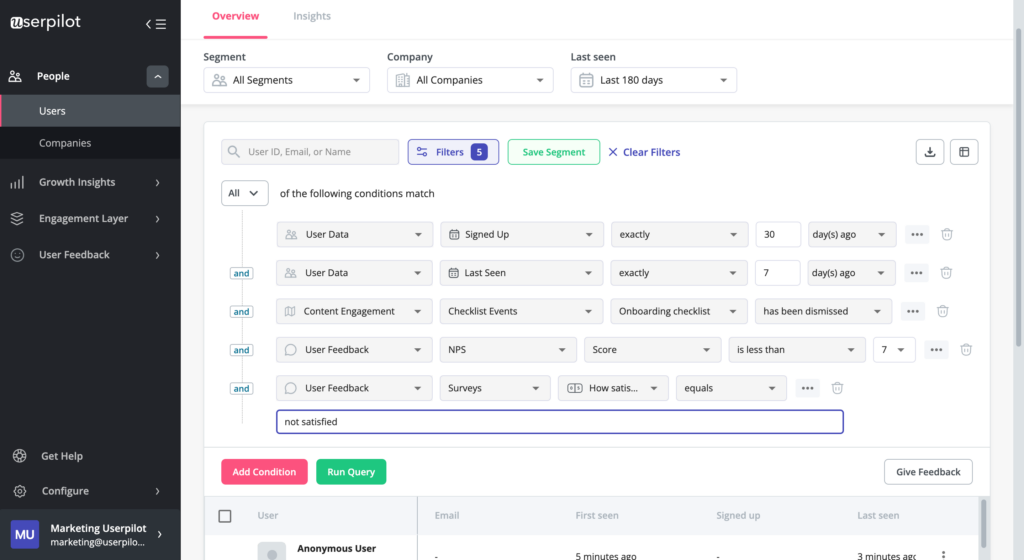
- Segmentation and conditional triggers:
- Userpilot allows for highly customized user segmentation. Users can set conditions based on a variety of factors, such as content engagement, user data like sign-up dates, and specific user actions like demo clicks.
- Advanced segmentation capabilities:
- It allows to filter users by multiple conditions simultaneously, such as last seen date, satisfaction scores from surveys, and engagement levels.
- Behavioral insights and user pathways:
- Userpilot also offers insights into user behaviors and pathways through its analytics platform.
- Funnel analysis:
- Userpilot’s funnel analysis feature tracks user progression through predefined steps, such as site visits, app downloads, and product purchases. This feature helps identify drop-off points and optimize the steps where users are losing interest or failing to convert.
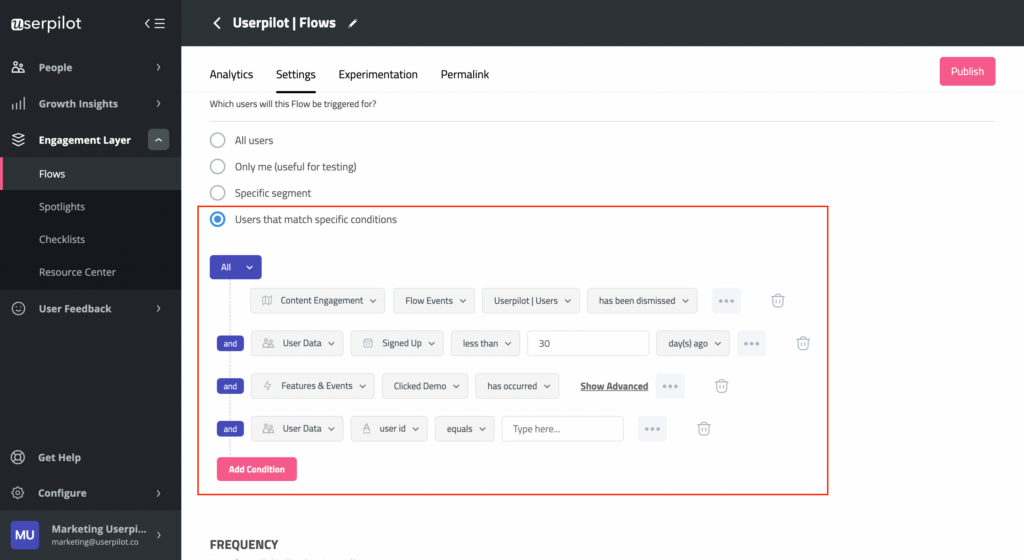
Through dynamic segmentation and conditional triggers, Userpilot allows companies to create customized messages and workflows.
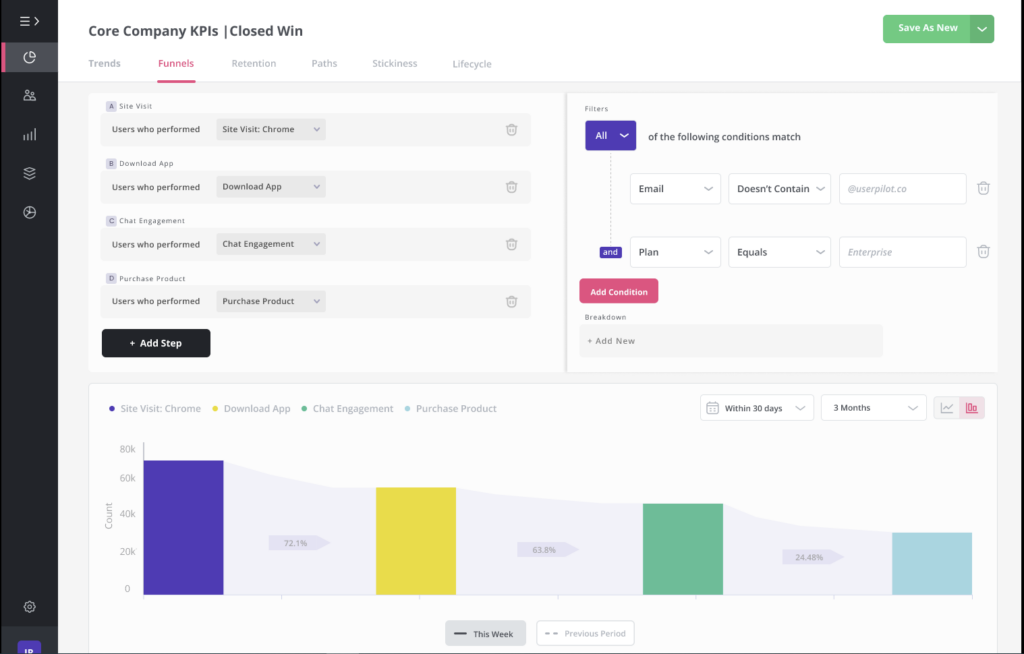
By understanding user behavior and automating responses based on specific activities, Userpilot helps businesses proactively engage users at critical moments.
3. Paddle: Subscription analytics
Paddle offers the complete payments, tax and subscriptions solution for SaaS. It automates your billing operations so you can focus on growth.
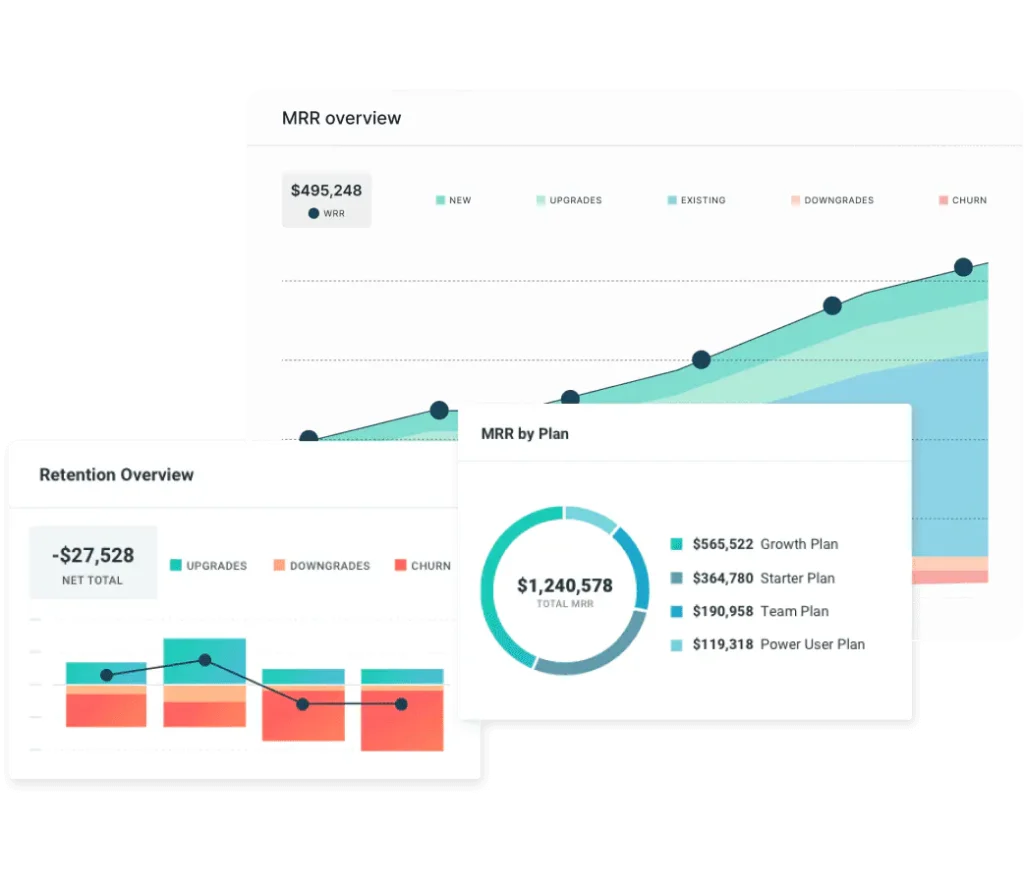
After it acquired ProfilWell, it now provides more SaaS metrics and subscription analytics that can help with churn analytics.
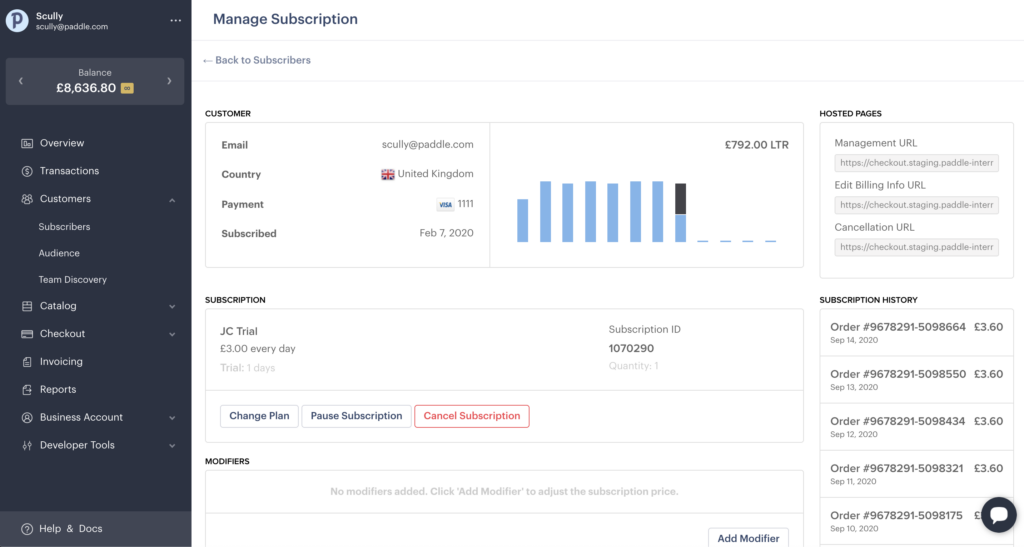
It breaks down churn in two sub-categories:
- Cancellations: These are the customers who actively choose to cancel their accounts.
- Delinquent. These are customers who churned when you are unable to bill their credit cards.
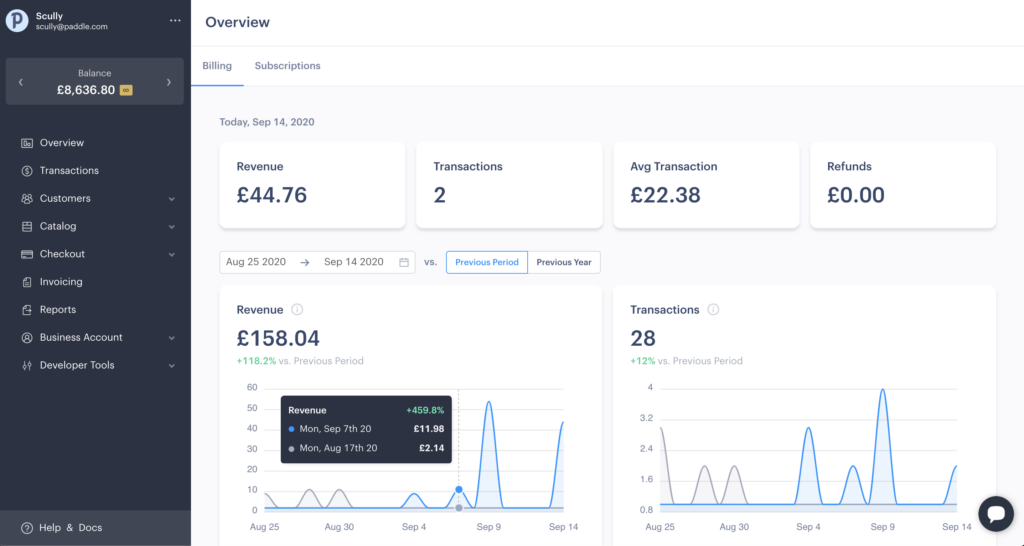
They make a distinction between the time in which a user tells you they don’t want your product anymore (i.e. cancels her account) and the time in which said cancellation actually takes place (i.e. said user’s MRR is subtracted from your totals).
4. Typeform: Churn surveys
Typeform is a widely recognized survey tool to gather feedback and insights directly from users. It provides different survey formats, templates and analytics which makes it a great choice for churn surveys.
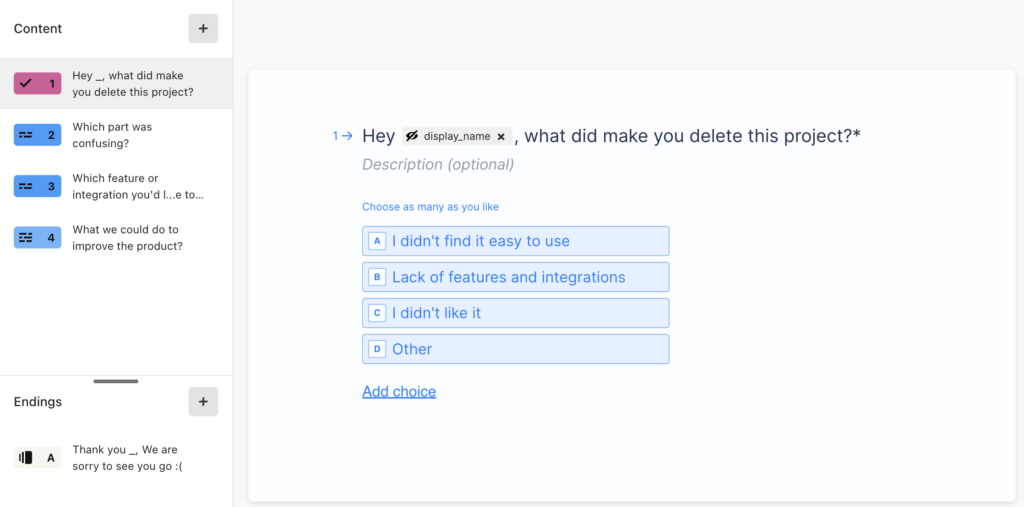
- User feedback collection:
- Typeform’s ability to collect feedback on why users may decide to delete a project or stop using a service.
- Data visualization and analysis:
- Typeform displays collected data. It uses bar charts to visualize the percentage and response count for each category of feedback.
- Detailed response records:
- It also provides a detailed record of individual responses, which includes the completion status, date, and specific feedback. This detailed view allows businesses to drill down into data, understanding the context and specifics of each user’s feedback.
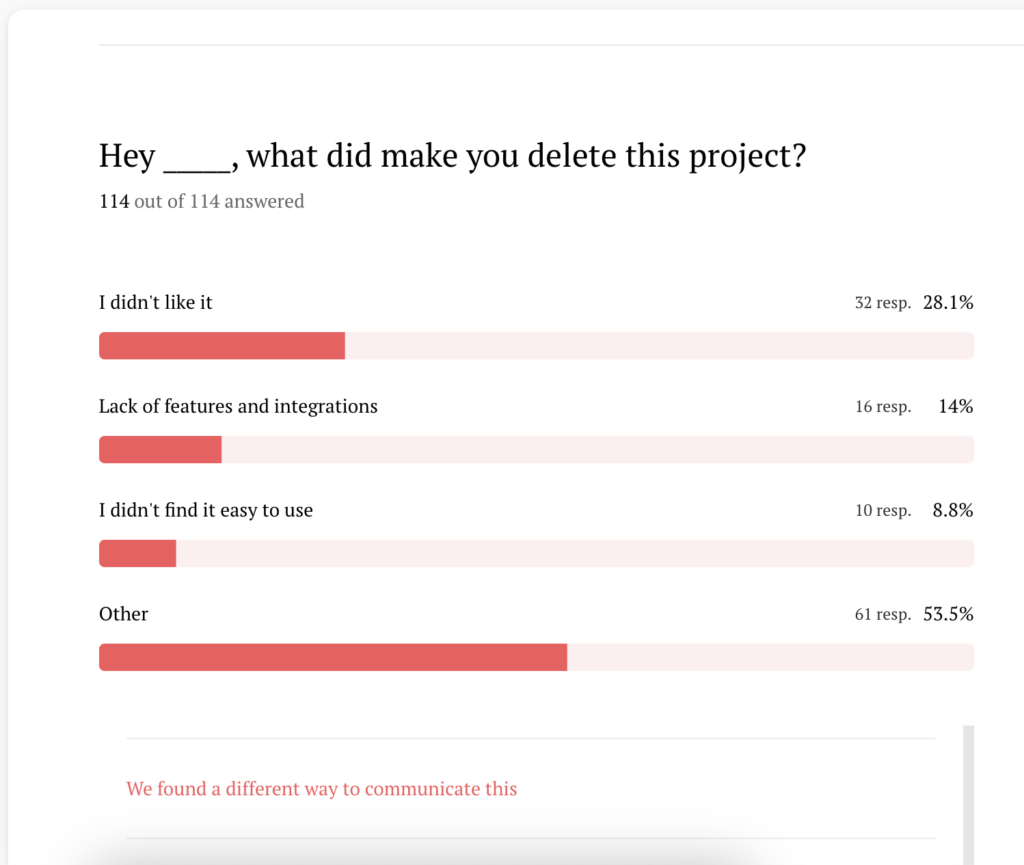
Typeform’s strength lies in creating highly engaging, visually appealing surveys that encourage completion and provide valuable insights.
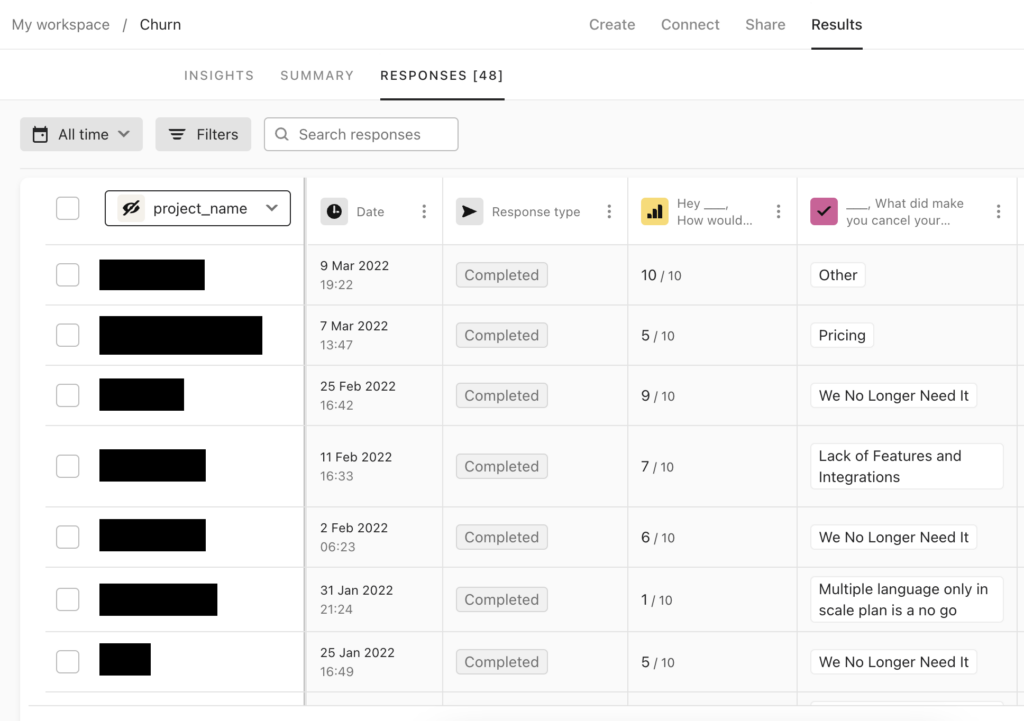
With its powerful analytics tools, Typeform helps businesses digest large amounts of data quickly through visual reports and breakdowns, making it easier to translate user feedback into actionable insights.
5. Recurly: Churn management
Recurly is a comprehensive subscription management platform designed to streamline billing processes and enhance subscriber retention for businesses.
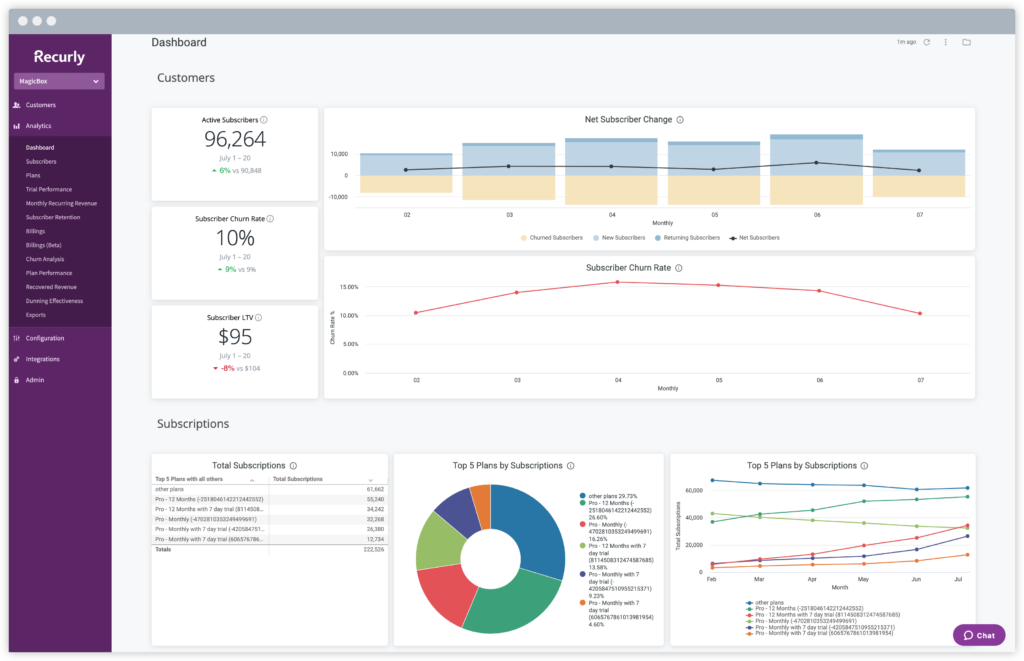
ProfitWell has partnered with Recurly to provide its users with deep insights into their financial metrics.
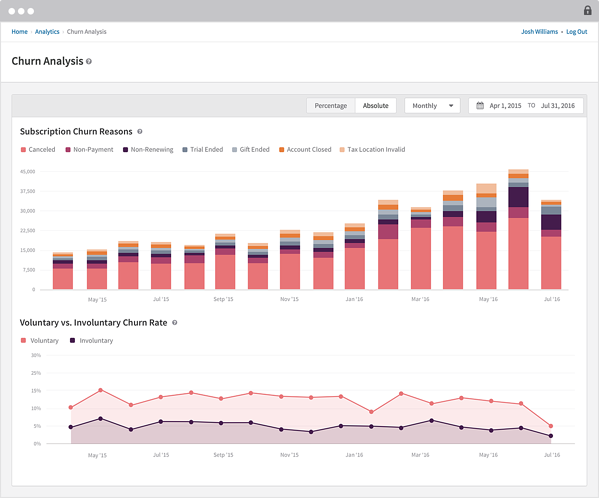
It helps in tracking subscription metrics, understanding revenue trends, and managing customer churn effectively.
- Churn and retention analytics:
- Recurly provides detailed churn analysis tools that categorize churn reasons, such as non-payment, trial end, and other subscription discontinuities.
- Subscriber retention metrics:
- Recurly tracks the retention rate over time, providing a breakdown by months, which helps businesses see the effectiveness of their retention strategies.
- Comprehensive dashboard:
- Recurly’s dashboard offers a view of the subscription lifecycle. Key metrics displayed include active subscribers, net subscriber change, churn rate, and lifetime value of customers.
- Revenue tracking and management:
- The platform provides extensive tools for monitoring revenue, including average revenue per customer, net billings, and recovered revenue.
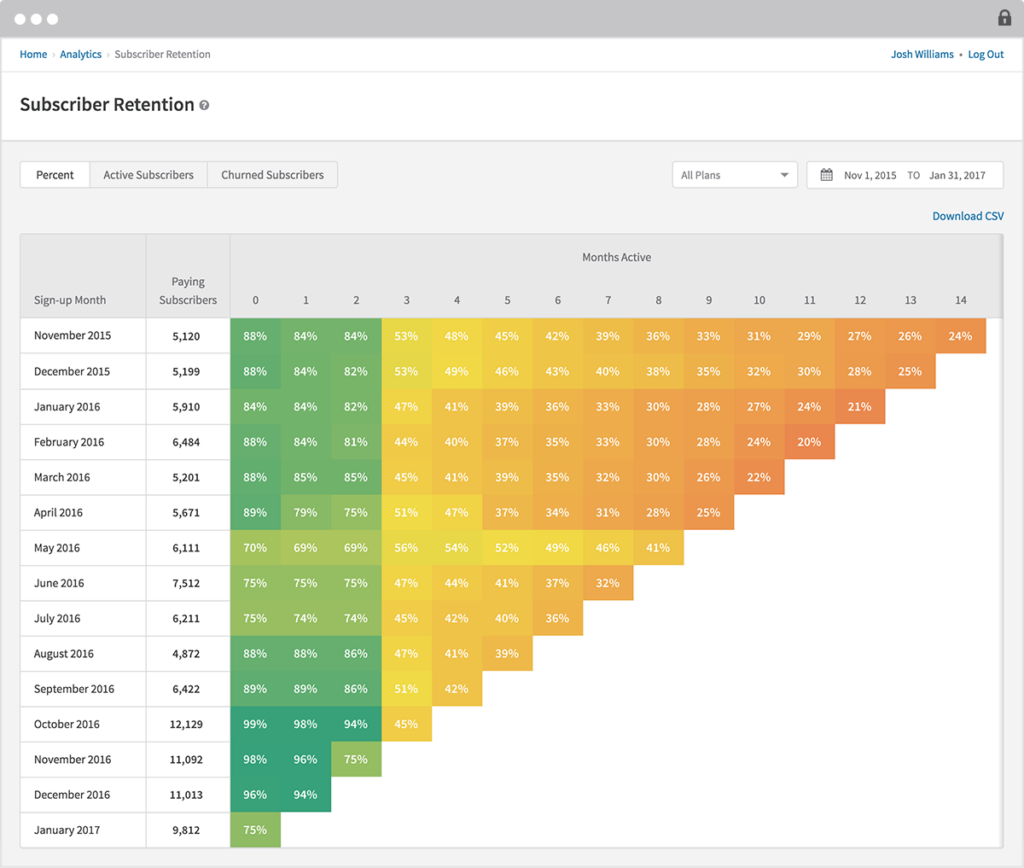
With its advanced analytics capabilities, Recurly provides actionable insights into customer behavior, subscription trends, and revenue performance. Effective management of failed payments through systematic dunning strategies helps in recovering revenue and reducing involuntary churn.
Conclusion
Effective churn management involves not only understanding churn rates but also using churn analytics to predict and prevent customer churn.
Implementing tools designed for churn analytics helps businesses turn data into actionable insights, driving proactive strategies for customer retention.
Key Takeaways
- Churn analytics involves deep examination of customer behaviors and interactions to predict churn.
- Employing churn analytics tools allows businesses to detect and address customer dissatisfaction early.
- Integrating various data sources and automating alerts enable quick responses to potential churn.
- Tools like UserMotion provide churn signals to detect potential churn before it happens.
- Churn analytics tools like Userpilot segment customers and customize retention approaches based on detailed data insights.
- Regular feedback surveys with Typeform help gather direct insights from customers, enhancing understanding of churn reasons.
- Paddle automates billing and subscription analytics, simplifying management and reducing involuntary churn.
- Recurly offers comprehensive churn and retention analytics, enabling businesses to categorize and address specific churn reasons.

